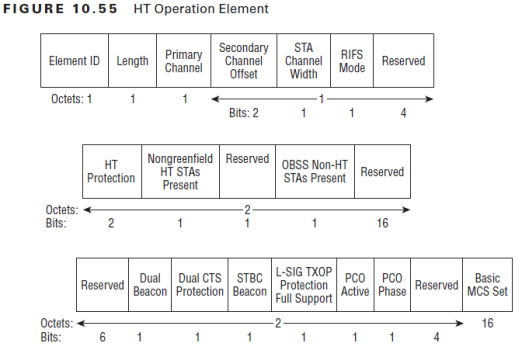Interoperability and coexistence
Both 11n and 11ac introduced optional features.
Station capabilities and operation
An HT station signals its capabilities using the HT capabilities element, a VHT station signals its capabilities using both the HT capabilities element and VHT capabilities element . These elements are present in the following management frames:- Beacon
- Association Request/Response
- Reassociation Request/response
- Probe Request/Response
Beacon transmission
The Beacon is always transmitted in a 20 MHz non-HT format on the primary channel:- in 2.4 G band, the DSSS/CCK format is typically used
- in 5 G band, the non-HT OFDM format is typically used
Channel operation

20 MHz BSS operation
An AP indicates 20 MHz BSS operation by setting the Secondary Channel Offset subfield in the HT Operation Information element to 0.20/40 MHz BSS operation
An HT AP indicates 20/40 MHz BSS operation by setting the Secondary Channel Offset subfield in the HT Operation Information element to a non zero value indicating the offset of the secondary channel relative to the primary channel (+1 or -1).All 20 MHz transmission would only use the primary channel, the secondary channel should be clear except for the 40 MHz transmission.
The Secondary Channel Offset field
This offset element is constructed as follows:
- Element ID: 1 byte
- Length: 1 byte
- Secondary Channel Offset: 2 bits
- 0 not allowed to transmit in 40 MHz
- 1 the secondary channel is above the primary channel
- 3 the secondary channel is below the primary channel

留言